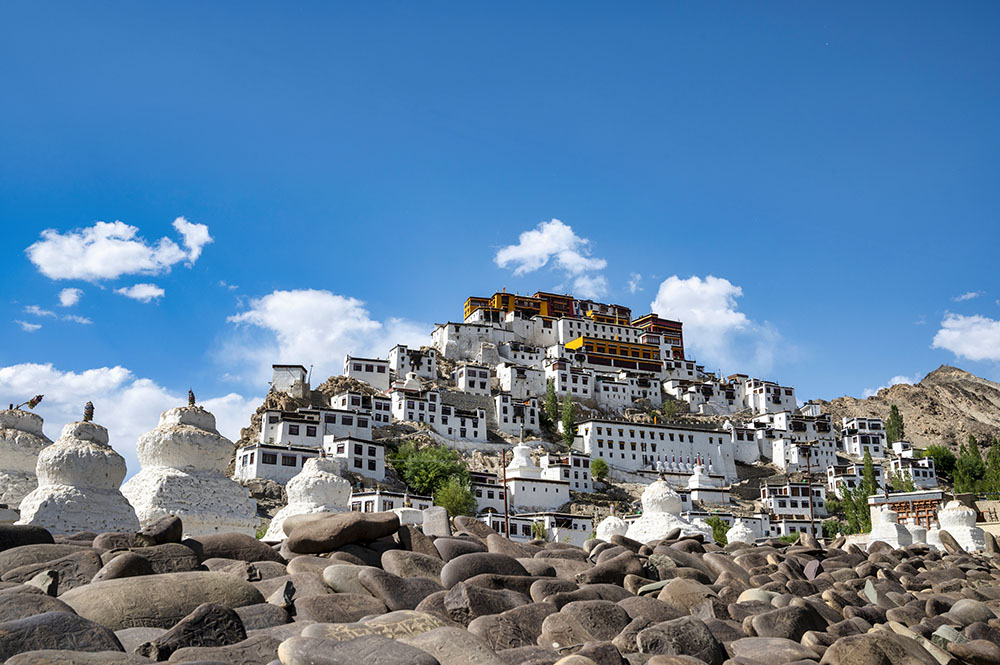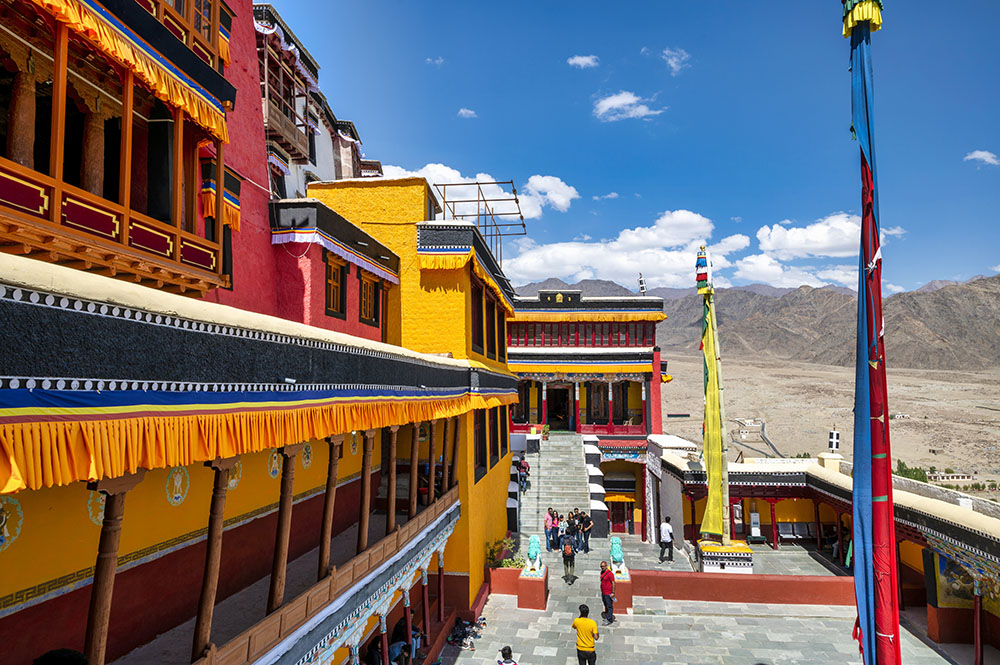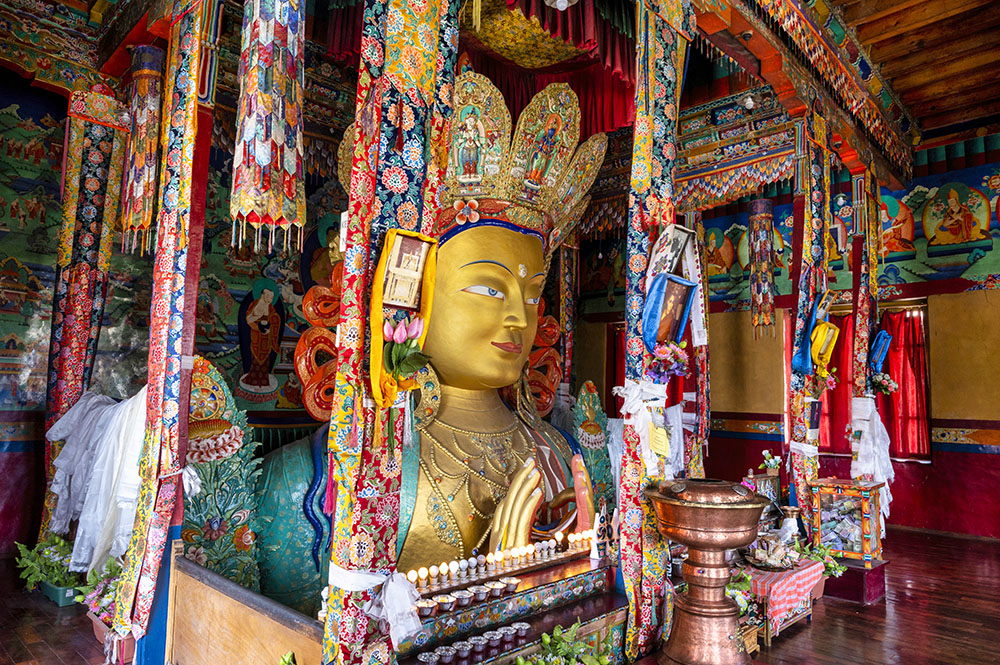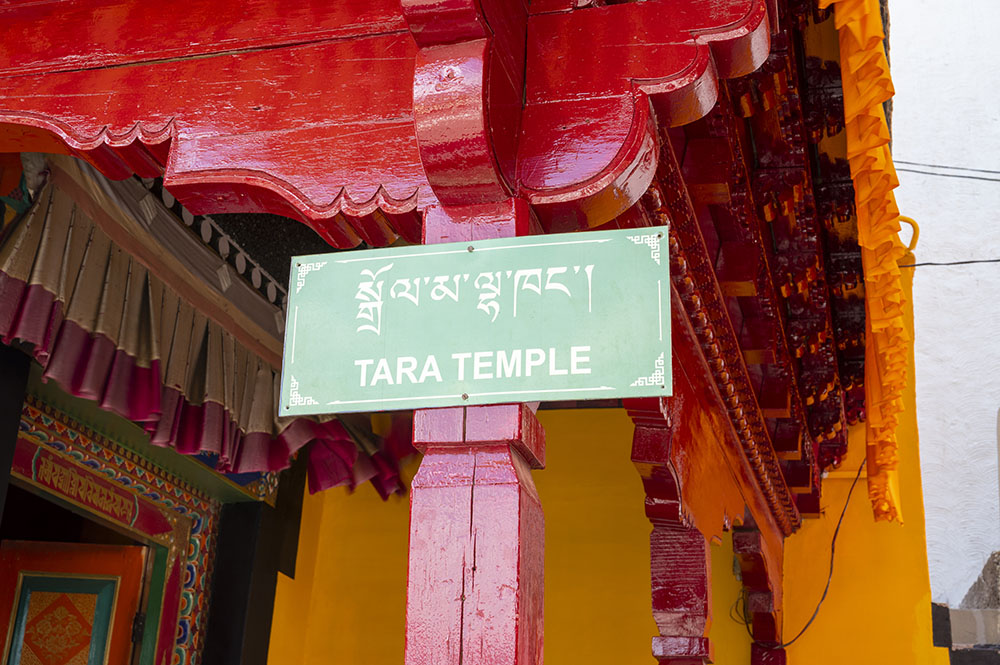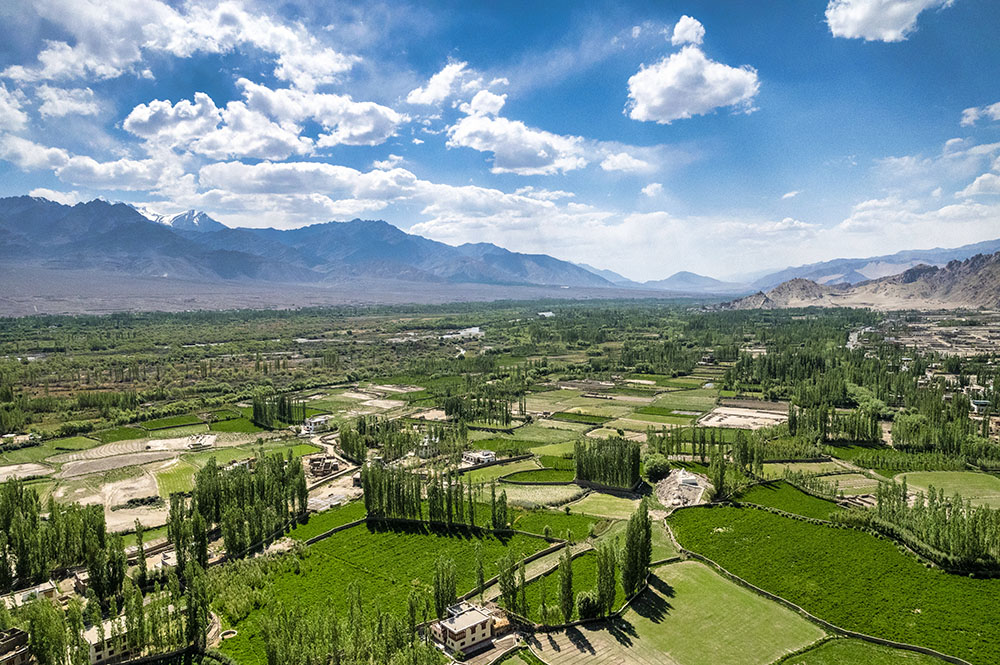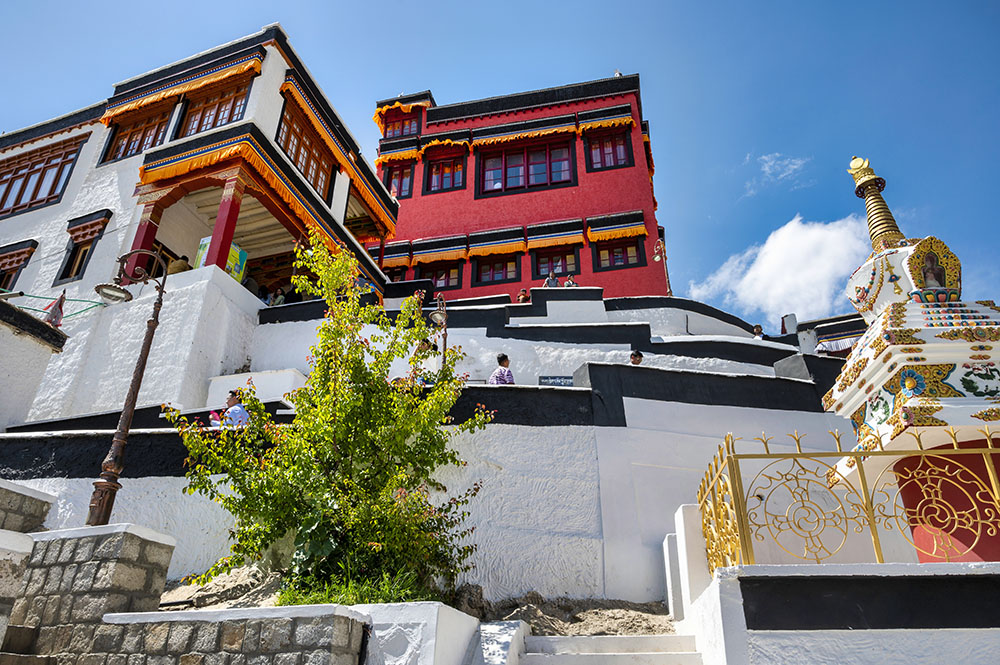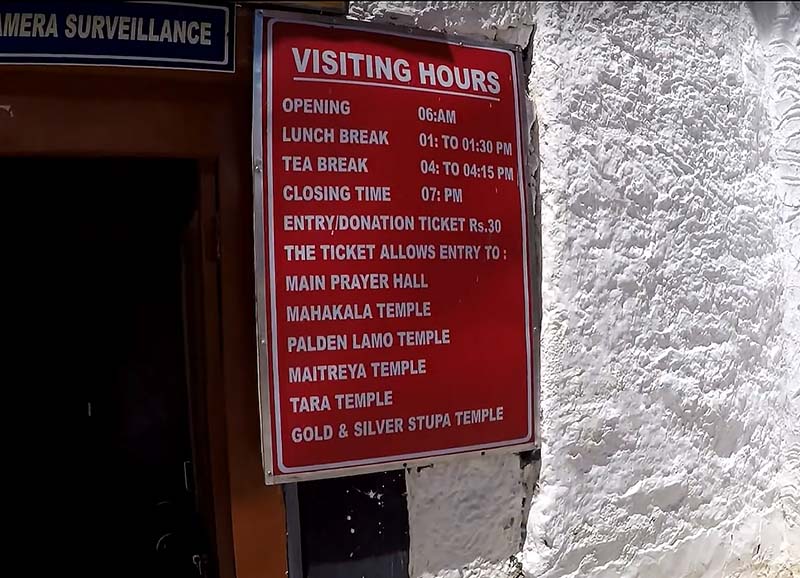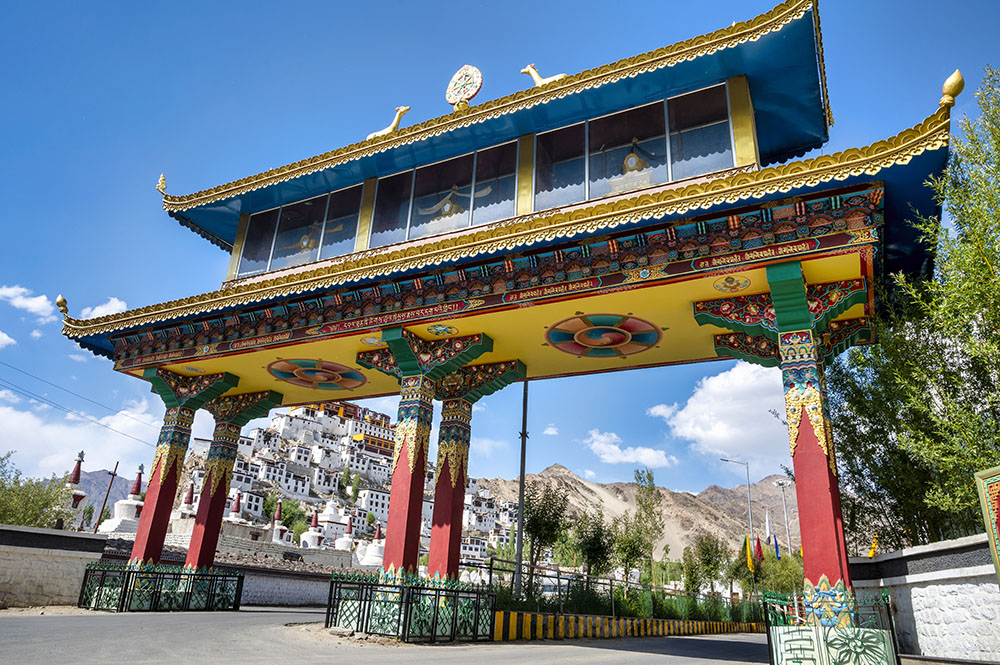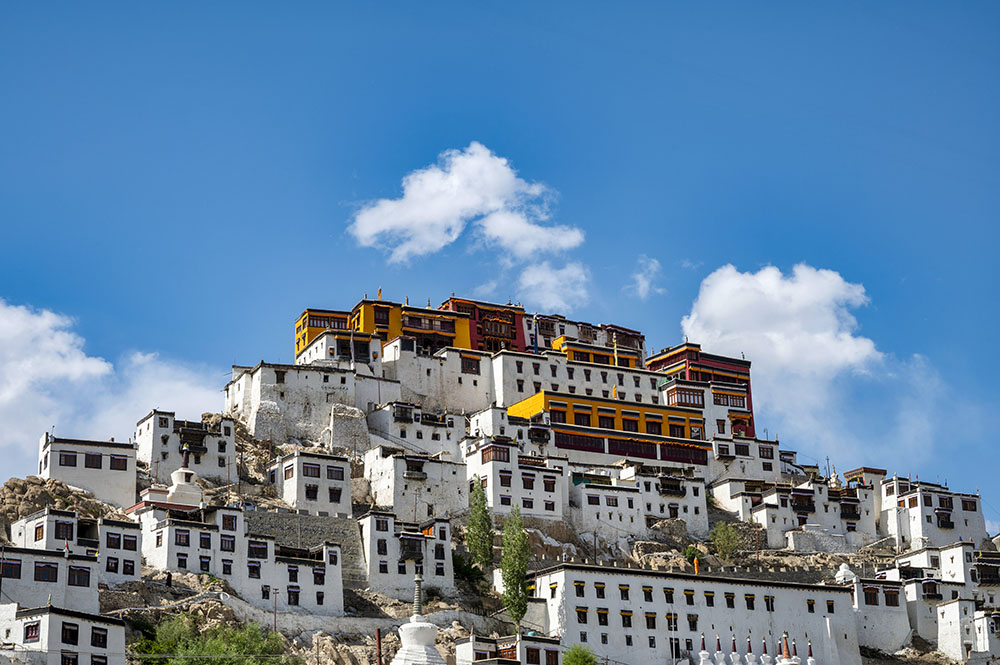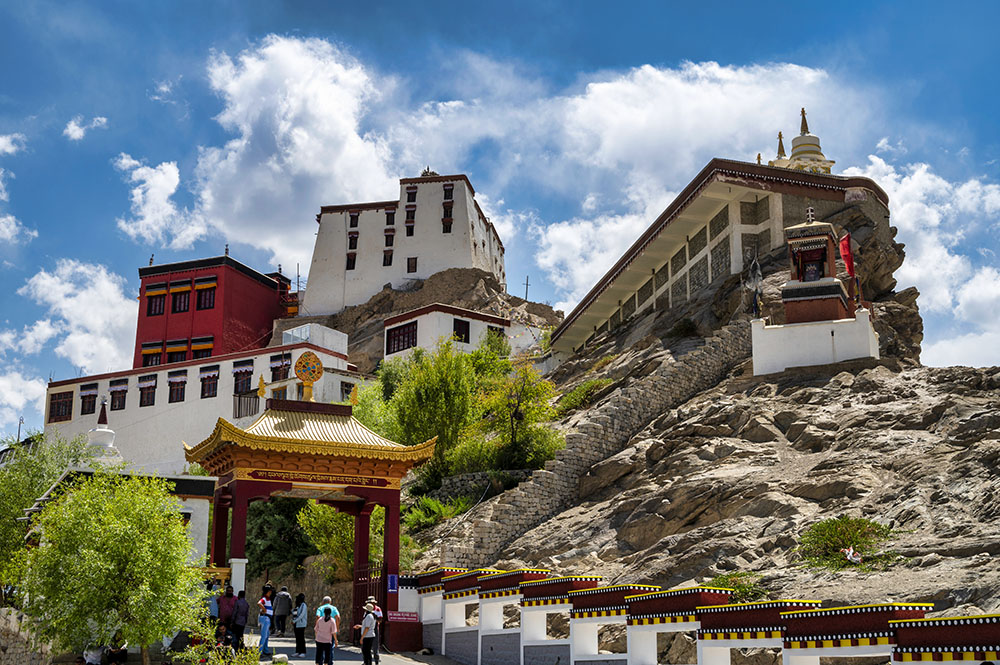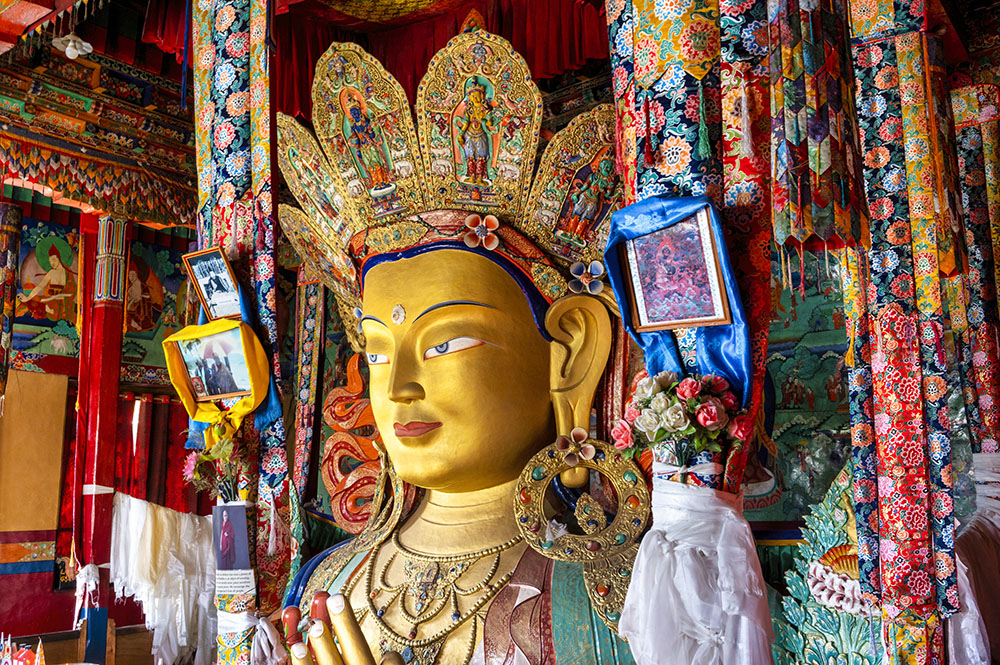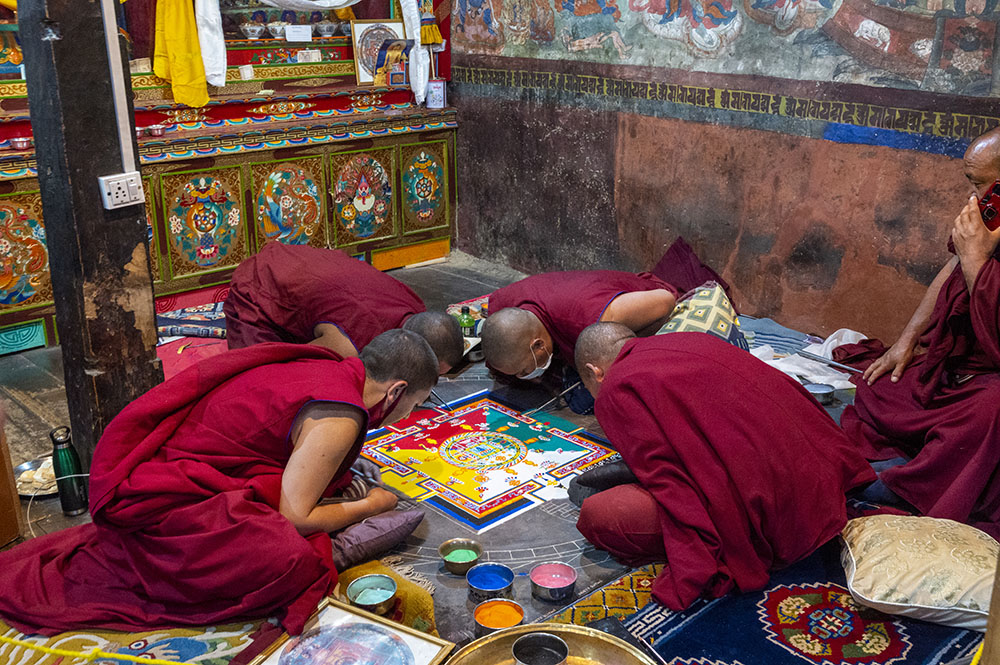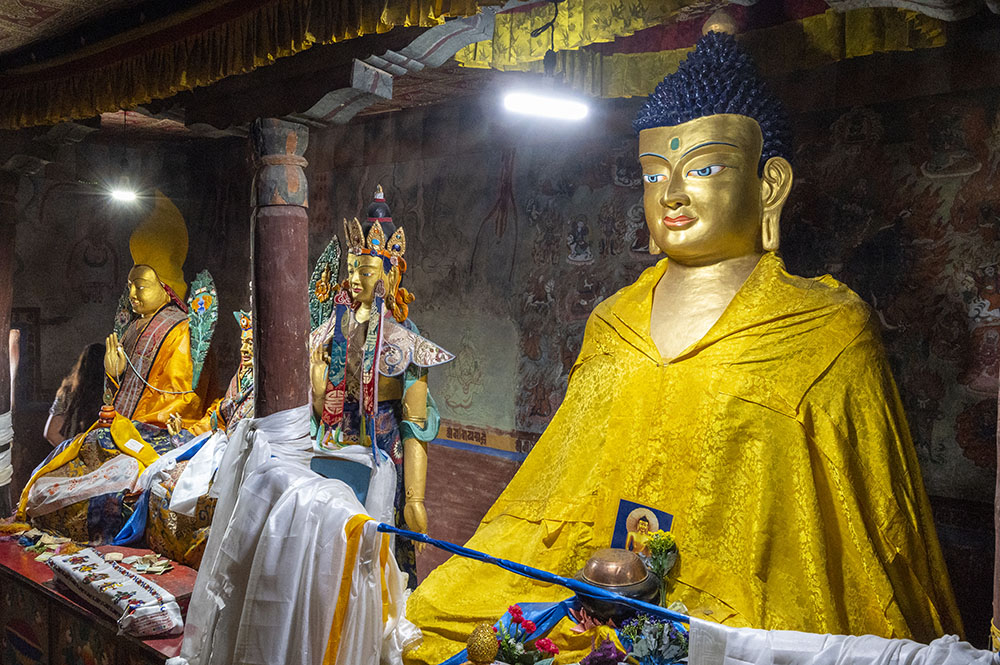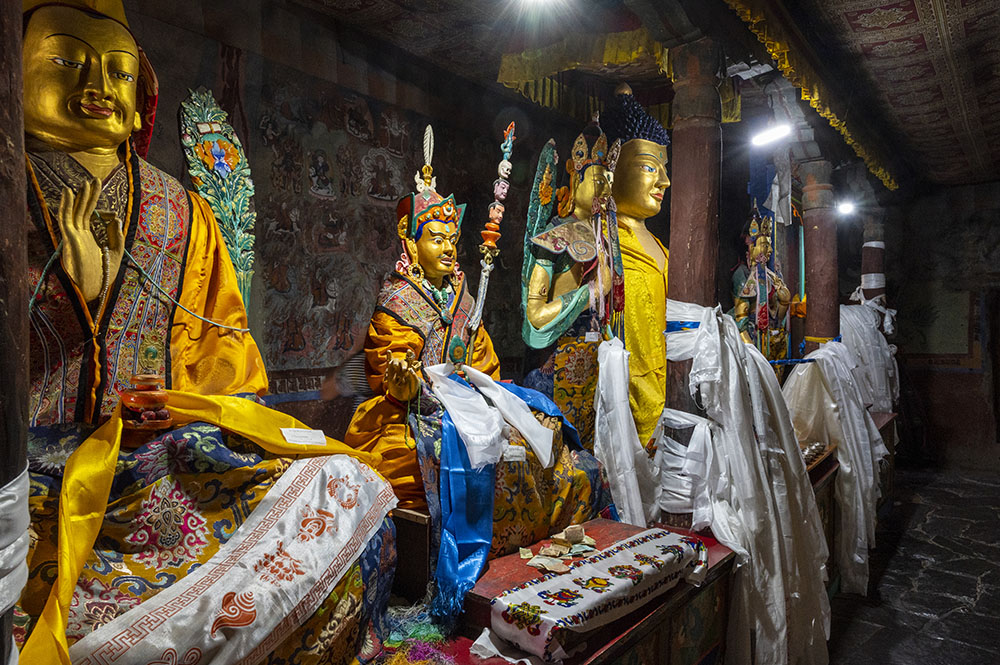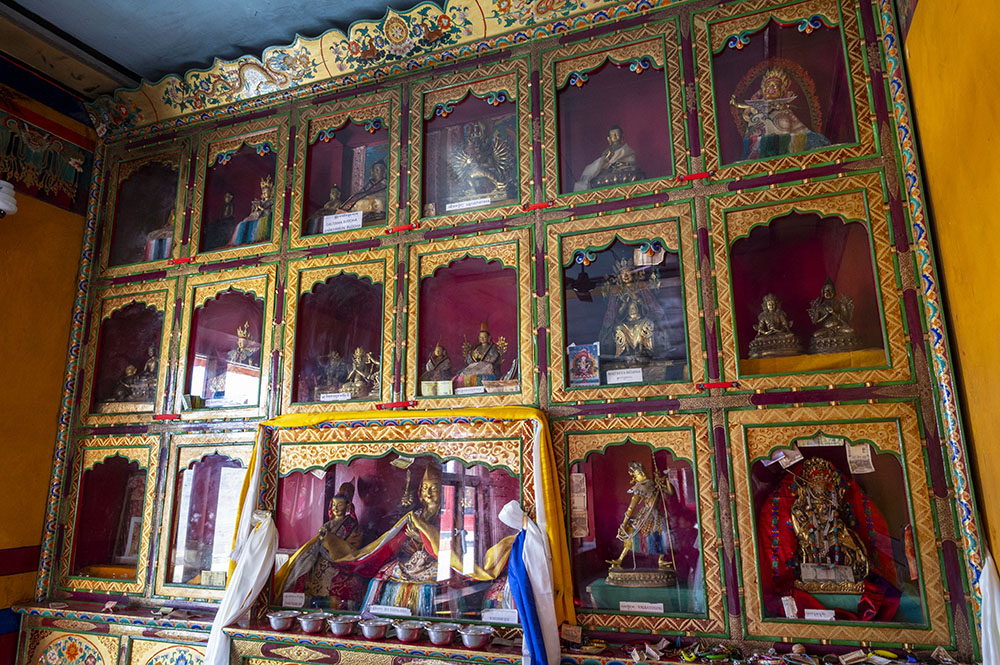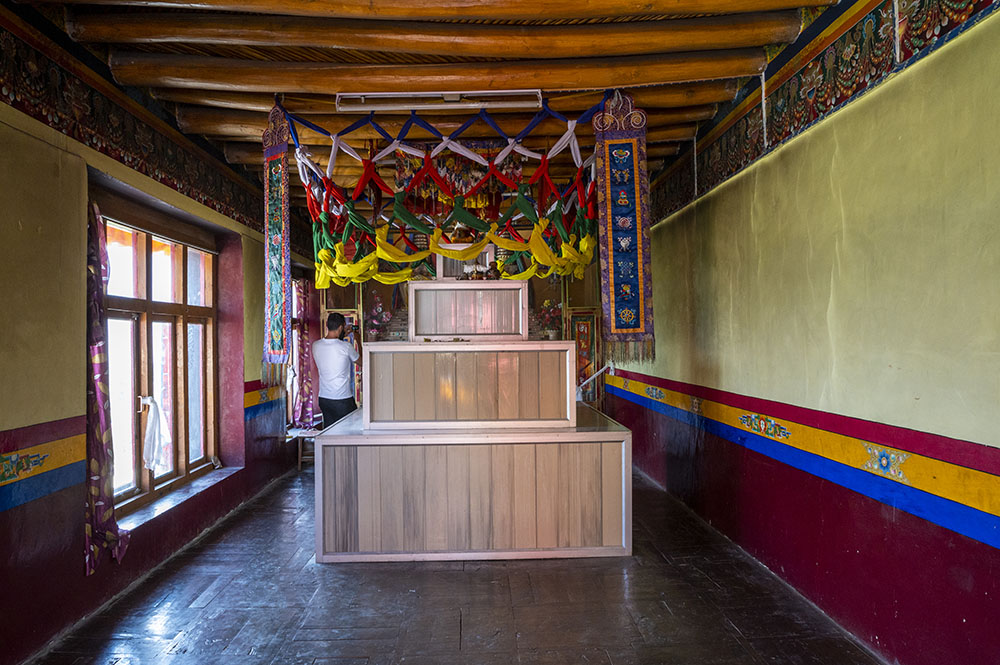There are three things about Thiksey Monastery that make it one of the most visited places in all of Ladakh. The first one is that it is absolutely gorgeous. The second one is its spectacular location and the third one is its close proximity to Leh City.
Also known as Thikse Gompa, this grand monastery is the largest in central Ladakh and sits at the top of a small hill, overlooking the entire valley around it. It is located at a distance of only about 19 kilometers from Leh and offers some of the best views you can get during your trip.
I was recently on a road trip to Ladakh that lasted for about 2 months. We covered the entire Ladakh region and visited pretty much all of the tourist attractions in Ladakh including Thiksey Monastery.
The post below is a brief narration of our visit to Thikse. It also has all the necessary information that you would need to plan your own trip. To read the previous parts of this travelogue, you can follow the links below.
Journey So Far:
- Karsha Monastery – Day 10
- Padum to Lamayuru via Lingshed – Day 11
- Lamayuru Monastery – Day 12
- Aryan Valley – Day 12
- Batalik Village – Day 12
- Umba La Pass – Day 13
- Manman Top – Day 13
- Hunderman Village – Day 14
- Kargil to Leh – Day 15
- Shey Palace & Monastery – Day 16
In my opinion, Thiksey is possibly the most beautiful monastery in all of Ladakh. It is so majestic in fact that if you were short on time and could afford to visit only one monastery, this is the one that you should pick. How you can plan your trip and include Thiksey Monastery in it is what I will be providing details on in this article.
Quick Navigation
About Thiksey Monastery
Also spelled as Tiksey, Thikse, or Thiksay, this monastery is truly a wonder in itself. It is among the largest monasteries not just in Ladakh but all of India.
Located on a hill slope, it was built as a fort monastery in the early 15th century and the current structure is a grand 12 stories high building painted in red, ochre, and white.
One of the prime attractions of the monastery is a grand 15 meters (49 ft) high statue of Maitreya Buddha, covering two stories of the building.
While other monasteries in Ladakh also have such large statues, the one in Thiksey Gompa is the largest. It was built to commemorate the visit of the 14th Dalai Lama in 1970 and took four years to complete.
Also Read: How to Plan a Trip to Leh Ladakh – A Complete Travel Guide
Different sections of the monastery are arranged on the hill slope in ascending order as per their importance. On the top of the hill are the main shrine and the residence of the Head Lama.
The monastery is home to a total of 60 lamas and also has an attached nunnery that houses 26 nuns. Its architecture bears resemblance to Potala Palace in Lhasa, Tibet, the former official seat of the Dalai Lamas. Due to this, the monastery is also referred to as ‘Mini Potala’.
What to See in Thiksey Monastery
As a common tourist who will not have much knowledge about Buddhism, there are three things that will be of interest. The first is the grand statue of Buddha, the second is the beautiful paintings on the walls of the monastery and the third is the awesome view you get from the monastery.
The path to the monastery is lined with chortens (stupas) and mani (prayer) and ends in the courtyard through an elaborate gateway, all of which is quite a sight in itself.
The main temples and other important structures are all built around this courtyard. Other rituals and cham dances too are performed in this courtyard at the time of different festivals.
Maitreya Buddha
The main point of interest is the Grand Buddha statue made of clay and copper and painted in gold. It is a 15 meters high statue that took 4 years to complete and was built to commemorate the visit of the 14th Dalai Lama to this monastery in 1970. It is the largest such statue in all of Ladakh and is really a sight to behold.
Assembly Hall
The assembly hall has a set for the Dalai Lama at the center, the head lama to the right, and a picture of a deity on the left. There are several murals of the Tibetan calendar with the Bhavacakra (Wheel of Life) depicted on the walls.
The hall also has an image of the Thousand-armed Avalokitesvara, murals of Mahakala and Sitatapatra, and 225 volumes of the Tengyur wrapped in silk.
Also Read: How to Handle Acute Mountain Sickness in Leh Ladakh
Tara Temple
After the assembly hall, you can also visit Tara Temple. It has 21 images of the goddess placed on glass-covered wooden shelves.
Temples on the Top Floor
You will then move further up to the top floor and visit the Lamokhang temple. Please note that women are not allowed on the top floor which also has the official residence of the head lama.
Rooftop
The excellent view that you get from the roof of the monastery will be the prime attraction for you as a tourist. If nothing else, then the view itself makes a trip to the monastery worth it.
If you are into photography, then this is one place where you can get some excellent shots of the Indus Valley flood plains.
Thiksey Monastery Festival
An annual festival known as Thiksey Gustor is held in the monastery in the month of either October or November. It is based on Tibetan Lunar Calendar so the exact dates of the festival vary each year. It is a 2-day event marked by sacred Cham dance by the monks.
The word ‘Gustor’ in Tibetan means ‘sacrifice of the 9th day’ and is a celebration of good over evil. The festival is held simultaneously in several monasteries for two days. The one that is held in Thiksey monastery is named Thiksey Gustor.
It begins with the preparation of a sacrificial cake, Torma, which indicates an evil entity or force. During the festival, the traditional Black Hat dancers perform the sacred mask dance.
The most important ceremony of the festival, however, is the enactment of the killing of King Langdarma. He was a king who ruled Tibet from 838 to 841 CE and is considered an evil king. It is said that he was possessed by demons.
The enactment is known as Argham. An effigy of Langdarma is made and then rituals are performed for 7 days. On the last day, the effigy is burnt, marking the victory of good over evil. The sacrificial cake Torma is cut and distributed by the Black Hat leader.
Take a look at festivals celebrated in Leh Ladakh for the exact dates of the festival in the year of your visit.
Best Time to Visit
There are two points of view if we talk about the best time to visit Thiksey monastery. On an overall basis, May to September is the best time to visit Ladakh and will also apply to Thiksey.
The weather at this time is very pleasant and perfect for tourists. Srinagar Leh Highway as well as Manali Leh Route will both be open and reaching Ladakh will not be difficult.
All hotels, guest houses, and tourism-related activities too will be open. Tourist places in Ladakh like Nubra Valley, Pangong Lake, and Tso Moriri will also be accessible.
If you wanted to attend the Thiksey festival, then you should plan your visit for October or November. But please note that October marks the beginning of the winter season in Ladakh and the temperature starts to drop several degrees below zero at night.
Manali and Srinagar roads may not be open any longer and it can snow anytime. Winters in general are harsh times here and you will have to prepare accordingly. To know more, please read How to Plan a Trip to Leh Ladakh in October or How to Plan a Trip to Ladakh in November.
Where is Thiksey Monastery
Thiksey Monastery is located at a distance of 17 kilometers from Leh on the Manali Leh Highway. To get here, you will start driving towards Karu from Leh and the monastery will fall to your left, a little after Shey Palace.
How to reach Thiksey Monastery in Leh
For this part, I am assuming that you have already arrived in Leh and are now planning a visit to Thiksey Monastery. However, if you want to know more about getting to Ladakh first, then I will recommend you take a look at How to reach Ladakh by Road, Bus, Air, or Train.
Depending on your time of arrival in Leh and your mode of travel, reaching Thiksey monastery is fairly easy. There is a motorable road that goes all the way to the monastery, most of which is actually the Manali Leh Highway itself.
Leh to Thiksey Monastery
From Leh, you will start driving on the Manali route, toward Karu. You will reach Choglamsar, then Shey, and then Thiksey, about 17 kilometers later.
There are two ways to get to the monastery. You can leave your vehicle on the highway itself and then climb a steep set of stairs to get to the gompa.
Or you can bring your car right to the parking spot of the monastery. To do this, turn left near Chamba Hotel and Restaurant on a narrow road that goes up to Thiksey. You will reach the parking spot in the picture below.
From the parking area, you will start walking on the road that goes into the monastery. There will be a huge golden gate where you will buy the entry ticket of Rs. 30 first. Keep walking for a short distance on the road and then you will climb up the stairs to enter the gompa.
Leh to Thiksey Bus
If you were traveling by public transport, then you will have to board a bus going from Leh to Sakti. The timings of the buses are 8.15 am, 8.30 am, 1.30 pm, 2.30 pm, 3.30 pm, and 4.30 pm. The fare per person will be Rs. 35.
Please note that this bus will drop you on the highway itself and not all the way to the monastery gate. After you get off the bus, you will have to walk the remaining distance. For more details, please read Local Bus Timings in Ladakh.
By Shared Taxi
If you weren’t traveling by your own vehicle and the bus timings weren’t matching yours, then the best way to board a shared taxi from the bus stand.
These leave at regular intervals all day long and you can actually find all the way going to the monastery itself. The fare per person will be around Rs. 50.
By Private Taxi
A more convenient way will be to rent a private taxi. That way, you get picked up from your hotel itself and brought back. But if you were doing this, do not rent one just for Thiksey.
Rent a taxi for an all-day-long tour of all monasteries around Leh and other tourist spots. Please read Taxi Charges in Leh Ladakh to know how much it will cost you.
Rented Bike
If you wanted something convenient but not as costly as a private cab, then you should opt for a motorcycle, like Royal Enfield. You can easily rent one in Leh and use it to move around between places.
Even if you do not want to rent one for the entire duration of your trip, I will still recommend getting one for at least one day in Leh City. Riding a bike on the roads of Ladakh is really an experience worth having.
If you weren’t too comfortable with a motorcycle, you can also opt for an automatic scooter like Activa. Please read Leh Ladakh Motorcycle Rental Rates to find out how much it will cost you.
Hitchhiking
The most cost-effective way would be to simply hitchhike and in Ladakh, it is not difficult at all. Thiksey Monastery is located on Manali Leh Highway, a busy road.
You will find plenty of locals and tourists traveling on it all day long. Someone in a car may not stop but a biker riding alone will not mind giving you a lift at all.
Thiksey Monastery Timings
Thiksey monastery’s opening hours are from 6 AM to 1 PM and 1.30 PM to 7 PM every day, including Sundays and national holidays. The monastery also remains closed for 15 minutes between 4 – 4.15 PM for the tea break.
Thiksey Monastery Entrance Fee
You will have to pay an entry fee of Rs. 30 per person to enter the monastery. The fee is the same for both Indians and foreign nationals. There is no parking charge.
How to Plan a Trip
There are three ways that a trip to Thiksey Monastery can be planned.
The first one is a monastery tour. You stay for a day in Leh City and spend it visiting all the nearby monasteries and other tourist attractions like Leh Palace, Shey Palace, and Shanti Stupa. If time allowed, you can also visit Gurudwara Patthar Sahib, Indus Zanskar Confluence, Magnetic Hill, Likir, and Alchi.
The second one is to incorporate the trip with Pangong Lake or Tso Moriri. It is the same road that you will take to get to both of these lakes.
So you can also cover Thiksey either while going to Pangong or Moriri or while returning. If you were doing this, another monastery that I will also recommend visiting is the Hemis Monastery known as the richest monastery in India.
The third way is to visit while commuting between Leh and Manali. For example, if you were coming from Manali, you can pay a short visit to the monastery before reaching Leh.
There is no permit required for it so you won’t be stopped anywhere. Or if you were planning to return via Manali, then you can cover the monastery while on the way.
Thiksey Monastery Accommodation
The entire stretch between Karu and Leh has several hotels that you can choose from. Chamba Hotel and Restaurant is probably the closest hotel near Thiksey Monastery but there are several others in both directions, towards Leh and Karu.
Thiksey Monastery Stay
The monastery offers the visitors an option to stay on the premises, in decent enough rooms at a very reasonable price. It is also known as the Thiksey Monastery guest house but these are just very basic rooms.
Before you decide to stay, please take a look at the rooms first and then make the choice. They may not be the best in terms of comfort but are definitely a cost-effective choice.
Mobile Network
BSNL has the widest coverage in all of Ladakh followed closely by Airtel and Jio. The thing that you should know, however, is that only postpaid phones work in Ladakh due to security reasons.
Prepaid phones do not work at all and will be dead as a paperweight. So, if you were carrying a postpaid BSNL, Airtel, or Jio phone, it will work fine in Thiksey. For more details, please read Mobile Connectivity in Leh Ladakh.
Leh to Thiksey Monastery
Now coming back to the travelogue, let me now talk about our visit to Thiksey Monastery. It was the 16th day of the trip and we decided to use it for a monastery tour of Ladakh.
The day started a little later than planned and we stepped out of our hotel at around 1 pm. The first destination was Shey Palace and Monastery where we spent about an hour. I have talked about Shey in the previous part of this travelogue.
After exploring the Shey palace, we stepped out and moved on to Thiksey Monastery. The drive hardly took us 15 minutes as the distance between Shey and Thiksey is only about 6 odd kilometers.
The gate to the monastery.
I was totally mesmerized by the first view of Thiksey monastery from the parking lot. I have been to a lot of monasteries but in my opinion, none of them was as grand or beautiful as this one.
We parked our car, walked to the ticket counter, and stepped in. It was the month of June which is the peak tourist season in Ladakh. As a result, there were a lot of people around and everything felt a little crowded.
History of Thiksey Monastery
The monastery also has an interesting tale about how it came into existence. It is said that in the early 15th century, Je Tsongkhapa, the founder of the Gelug School of Tibetan Buddhism (also known as the ‘Yellow Hats’) sent 6 of his disciples to different parts of Tibet to spread the teachings of the new school.
One of these disciples, Jangsem Sherab Zangpo, arrived in Ladakh and met the king and presented a small statue of Amitayus as a gift. The Ladakhi king was impressed by the gift and decided to help the disciple in establishing a new monastery.
In the year 1433, the monastery was built in the village of Stagmo and Gelugpa order was introduced in Ladakh. Years later, Palden Zangpo, a disciple of Sherab Zangpo, continued the work of his teacher in Ladakh and decided to build a larger monastery.
According to a popular narrative, the location of the new monastery at Thiksey was decided after a mystical episode. It is said that once, Sherab Zangpo and Palden Zangpo were performing a sacred ritual. Upon its completion, they took the ritual torma (figures and objects made of flour) to be disposed of in the valley or the river.
As they were about to throw away the torma, two crows appeared out of nowhere, snatched the ceremonial plate containing the torma, and flew away. The plate, after a long search, was then found on top of a hill above Thiksey Village.
It was placed on a stone and was in an undisturbed condition. Interpreting this mystical event as a divine directive, the monks decided to set up the new monastery at the same spot and the first temples were constructed at Thiksey.
Also Read: How to Plan a Trip to Ladakh with family
Architectural Style
The monasteries in Ladakh and Tibet commanded and controlled the region, land, and agricultural produce. There was a time when Thiksey grew in prominence and controlled 1,327 acres of land and about 25 villages.
It also administered ten other monasteries in the region, such as Diskit, Spituk, Likir, and Stok. This often led to conflicts with rival sects of monasteries for political and material control over the region.
This is why the monasteries were built like forts, with thick peripheral walls, and at a strategically selected high altitude location; to protect its inhabitants and wealth from rival attacks. One visit to the monastery and you will clearly see that Thiksey is a classic example of such a fortress-type monastery.
Exploring the Monastery
There is not really a lot more to write about so I will let the pictures do the rest of the talking. This is the courtyard of the monastery.
The Grand Buddha Statue
I am not really sure what these Lamas were doing. But it looked like a ritual to finalize the dates of something.
Other Idols in the monastery
Some more pictures from the other temples.
It took us over 90 minutes to explore the Thiksey monastery properly. As per the original plan, we were also thinking of exploring the monasteries of Stakna and Hemis on the same day. But the time we stepped out of Thiksey Monastery, our plan started to change a little.
It was close to 5 pm and I knew that covering both Stakna and Hemis will not be possible anymore. We will have to pick one and the one in Stakna was closer.
Shanti Stupa
After a bit of a discussion though, we decided to leave both monasteries for a later day in the trip. For now, we agreed to drive back to the hotel, rest for a little while, and then drive to Shanti Stupa to view the sunset from there.
On our way to the hotel, I noticed Zorawar fort. There weren’t many people around there at that time and the fort was mostly empty. It was a part of our itinerary for a visit in the later days. But noticing that there was no tourist crowd at the fort at that time, we stopped and decided to pay a visit.
As it turned out, for visiting Zorawar fort, one is required to first go to Leh Hall of Fame and get tickets from there. There is no ticket counter at that fort and without going to the Hall of Fame first, you will not be allowed to enter Zorawar fort.
Disappointed, we returned to our hotel. The sun was still harsh, even though it was close to 5.30 pm. So we just relaxed in our hotel for a little while and then stepped at 6.30 pm to go to Shanti Stupa.
- Journey Ahead: Sunset from Shanti Stupa, Leh
Our visit to Shanti Stupa however turned out way different than we thought. Why? Because I lost my newly bought GoPro there. Did I find it again? Yes, but 2 days later. Please click on the link above to continue reading the next part of this travelogue and to find out how this story unfolded.
Conclusion
I hope the pictures and details above on Thiksey Monastery in Ladakh were of help. If you have any questions, you can contact me on Instagram and I will be happy to answer. You can also consider subscribing to my YouTube channel and asking a question there.
Error: No feed found.
Please go to the Instagram Feed settings page to create a feed.

